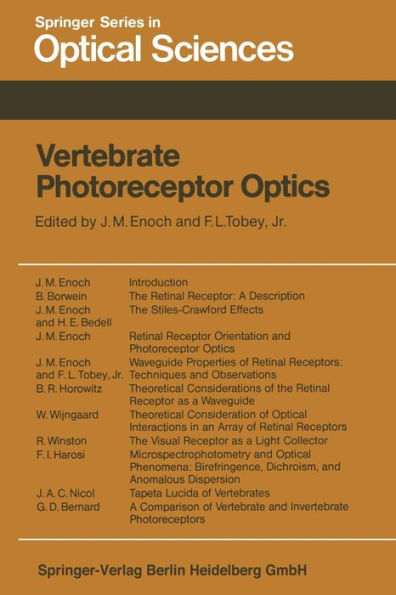Vertebrate Photoreceptor Optics
It is in the receptors of the vertebrate retina that the characteristic visual process - the transduction of radiational energy into physiological activtty of a different kind - takes place. The way these receptors modify or redistribute the incident radiation and thereby control the light ab sorption by the visual pigments they contain, is the central theme of this book. As far back as 1843 Brucke put forward a well-reasoned model for the optics of a receptor, assuming simple ray optics, and it is already some forty-seven years since the dependence of receptor sensitivity on retinal angle of incidence was established experimentally as an important factor in human vision and as one by which the direction of alignment of receptors in the living eye might be determined. But it is to Professor J. M. Enoch, editor and author of several major contributions to this volume, that we owe the first experimental demonstration (in 1961) of the wave-mode propagation of light in vertebrate visual receptors, as well as the results of some thirty years devoted research concerned with all questions of receptor optics, particularly directional sensitivity and receptor alignment, both for normal vertebrate eyes and for pathologically modified eyes. His work on the latter has opened up a whole range of clinical possibilities.
"1000911999"
Vertebrate Photoreceptor Optics
It is in the receptors of the vertebrate retina that the characteristic visual process - the transduction of radiational energy into physiological activtty of a different kind - takes place. The way these receptors modify or redistribute the incident radiation and thereby control the light ab sorption by the visual pigments they contain, is the central theme of this book. As far back as 1843 Brucke put forward a well-reasoned model for the optics of a receptor, assuming simple ray optics, and it is already some forty-seven years since the dependence of receptor sensitivity on retinal angle of incidence was established experimentally as an important factor in human vision and as one by which the direction of alignment of receptors in the living eye might be determined. But it is to Professor J. M. Enoch, editor and author of several major contributions to this volume, that we owe the first experimental demonstration (in 1961) of the wave-mode propagation of light in vertebrate visual receptors, as well as the results of some thirty years devoted research concerned with all questions of receptor optics, particularly directional sensitivity and receptor alignment, both for normal vertebrate eyes and for pathologically modified eyes. His work on the latter has opened up a whole range of clinical possibilities.
54.99
In Stock
5
1

Vertebrate Photoreceptor Optics
486
Vertebrate Photoreceptor Optics
486Paperback(Softcover reprint of the original 1st ed. 1981)
$54.99
54.99
In Stock

Product Details
| ISBN-13: | 9783662135129 |
|---|---|
| Publisher: | Springer Berlin Heidelberg |
| Publication date: | 04/10/2013 |
| Series: | Springer Series in Optical Sciences , #23 |
| Edition description: | Softcover reprint of the original 1st ed. 1981 |
| Pages: | 486 |
| Product dimensions: | 6.10(w) x 9.25(h) x 0.04(d) |
From the B&N Reads Blog
